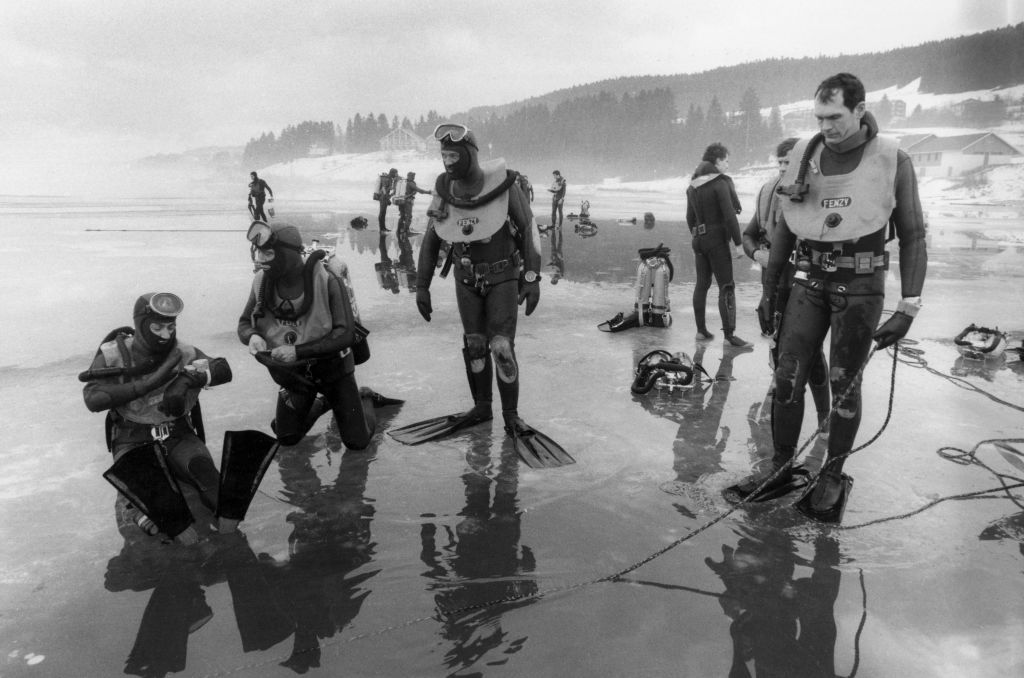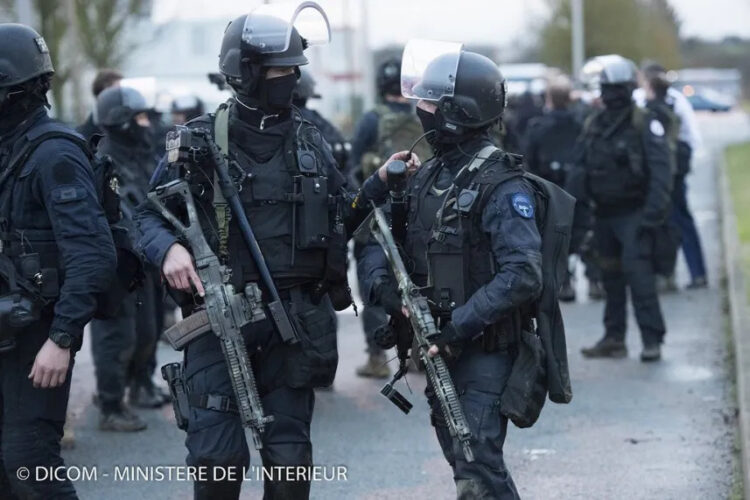| For Other French Units, click below | ||
|---|---|---|
| Foreign Legion | Commando Marine | Fusilier Marins |
| For Other International Units, click below | ||
| F.B.I. | Eko Cobra | GSG 9 |
| G.I.S. | B.O.P.E. | U.E.I. |
Training of Gendarmerie nationale and GIGN diving commandos on the frozen Lac Saint-Point, January 1985. (Photo Credit: Patrick AVENTURIER / Gamma-Rapho / Getty Images)
The French Gendarmerie Intervention Group, commonly known as GIGN (Groupe d’Intervention de la Gendarmerie Nationale), is a specialized counter-terrorism and hostage rescue unit within the French Gendarmerie. It is one of the most renowned and respected special operations forces in the world. The GIGN’s primary mission is to respond to high-risk situations involving terrorism, hostage-taking, and serious violent crimes in France and abroad.
Throughout its history, GIGN has gained a reputation as one of the world’s premier special operations forces, known for its professionalism, expertise, and successful handling of critical situations. The unit’s ability to respond swiftly and effectively to terrorist threats has made it a key component of France’s national security strategy. GIGN’s commitment to maintaining a low-profile and discreet approach to its operations has added to its mystique and effectiveness in combating terrorism and protecting public safety.
The history of the French Gendarmerie Intervention Group (GIGN) dates back to the early 1970s when a series of terrorist incidents in France highlighted the need for a specialized counter-terrorism and hostage rescue unit. GIGN was officially established on April 1, 1974, in response to the rise of international terrorism and domestic incidents in France. The unit was created by Christian Prouteau, a lieutenant colonel in the French Gendarmerie, who sought to form a highly skilled and trained force to tackle terrorism and handle high-risk situations. While many of their missions are conducted with utmost discretion, some notable GIGN operations have been made public.
Over the years, GIGN expanded its capabilities beyond counter-terrorism to include hostage rescue, combating organized crime, and supporting law enforcement in high-risk situations. The unit underwent continuous training and improvement to enhance its skills and adapt to evolving threats. During the 1980s and 1990s, GIGN gained international recognition for its involvement in several high-profile operations, including hostage rescues, counter-terrorism operations, and missions abroad.
“S’engager pour la vie.” (“A commitment for life.”)
— The motto of GIGN.
In 1984, GIGN established a specialized unit known as the Parachute Intervention Squadron (EPIGN). EPIGN is trained in airborne operations, parachuting, and special reconnaissance, further enhancing GIGN’s capabilities. GIGN has collaborated with other elite special operations units worldwide, sharing expertise and conducting joint training exercises. This cooperation strengthens their collective ability to combat terrorism and handle complex crises. GIGN continues to be actively involved in counter-terrorism and high-risk situations both within France and abroad. The unit remains at the forefront of France’s efforts to combat terrorism and safeguard its citizens.
- In 1976, just two years after its creation, GIGN was first deployed in an operation known as “Opération Loyada.” The mission involved rescuing 30 hostages held by two terrorists on a hijacked Air France flight in Djibouti. The operation was successful, with GIGN neutralizing the terrorists and freeing the hostages.
- In what is known as the Ouvéa Hostage Crisis (1988), Kanak separatists took hostages in a gendarmerie on the French territory of New Caledonia. After negotiations stalled, the GIGN was deployed to rescue the hostages. In a complex operation involving amphibious landings and precision tactics, GIGN successfully liberated the hostages and brought an end to the crisis.
- The Marseille Hijacking (1994). In December 1994, four members of the Armed Islamic Group (GIA) hijacked Air France Flight 8969 in Algiers, intending to crash it into the Eiffel Tower. The aircraft was flown to Marseille, France. GIGN operatives stormed the plane at Marseille’s airport and engaged in a fierce gunbattle with the hijackers, killing them and rescuing the hostages.
- In January 2015, Amedy Coulibaly, who was responsible for the Charlie Hebdo shooting, took hostages at a kosher supermarket in Porte de Vincennes, Paris. GIGN conducted a simultaneous operation with the RAID (another French special operations unit) and the police, neutralizing the perpetrator and freeing the hostages. This is know as the Porte de Vincennes Siege (2015).
- GIGN has also been involved in counter-terrorism operations in the Sahel region of Africa as part of France’s broader Operation Barkhane. This operation aims to combat jihadist insurgency in the region and support regional partner countries in their fight against terrorism.
Key features of the GIGN:
- The unit was formed to address the need for a specialized force capable of dealing with complex and dangerous situations.
- GIGN operatives undergo rigorous and extensive training to prepare them for their demanding missions. The selection process is known to be highly challenging, and candidates must demonstrate exceptional physical and mental capabilities.
- GIGN specializes in counter-terrorism operations, including rescuing hostages held by terrorists, neutralizing armed and dangerous suspects, and protecting sensitive sites and public figures.
- While primarily tasked with domestic operations, the GIGN has also been involved in international missions to assist other countries in combating terrorism and resolving critical situations.
- GIGN operators are equipped with state-of-the-art weaponry, advanced surveillance tools, and specialized equipment to carry out their missions effectively.
- GIGN is known for its low-profile approach and strict adherence to confidentiality. The unit rarely publicizes its operations, focusing on achieving its objectives efficiently and discreetly.
- GIGN works closely with other national and international law enforcement and military units to share expertise, intelligence, and coordinate efforts to combat terrorism and transnational threats.
Gear:
Assault rifles
- Heckler & Koch G3 TGS
- SIG SG 550
- HK33EA2
- GIAT FAMAS F1
Sniper rifles
- AW
- AWS
- AW SM
- PGM Hecate II
Sidearms
- Manurhin MR73
- Glock 17 and 19
- Sig Sauer P228
- Smith & Wesson 686 GFS
- FN Five-Seven
- GIAT PAMAS G1S
- SiG-Sauer PRO SP 2022
In 2017 the French Special Police GIGN selected the CZ BREN 2–In 7.62x39mm carbine for service.
Submachine guns
- Heckler & Koch MP5 – various versions
- FN P90 Tactical
Shotguns
- Remington 870
- Franchi SPAS-12
Standards
Candidates undertake a one-week pre-selection screening followed by, for those accepted, a fourteen-month training program. Mental ability and self-control are important, in addition to physical strength. Similar to most special forces, the training is stressful with a high rate of failure, especially in the initial phase; only 7–8% of the volunteers complete the training process. AGIGN candidates undertake a one-week pre-selection screening followed by an eight-week training program.
GIGN training consists of:
- Weapon handling
- Combat shooting and marksmanship training
- Airborne courses, such as HALO or HAHO jumps, paragliding, and heliborne insertions
- Underwater combat, swimming, diving, and naval boarding
- Hand-to-hand combat training
- Undercover surveillance and stalking (investigative cases support)
- Infiltration and escape techniques
- Explosive ordnance disposal
- Chemical, biological, radiological, and nuclear device neutralization
- Survival and warfare in tropical, arctic, mountain and desert environments
- Diplomacy and negotiation skills
The GIGN trains alongside other counterterrorist units from NATO countries, including the American FBI HRT, British SAS, Australian SPS, German GSG 9, and Irish Garda ERU.
To join this unit, one must be a French Citizen and younger than 34 years at the beginning of the selection course. The pre-selection phase to be selected for the main course is one week long. The attrition rate during the selection phase is very high. Less than 10 % after each training course will call themselves G.I.G.N.
Every year, at the same time of the year, usually about 100 – 150 Candidates present themselves at the GIGN center to try out to become a GIGN operator. After the first week of formation, the number of candidates usually drop down to 20-30. The selection course lasts 3 months. It is followed by another 8 months of special training, which if successfully passed, opens the doors to one of the operational teams. The first week, where the number of candidates is drastically reduced, is incredibly hard. A candidate will walk on an unstable plank, raised at least 20 meters above ground, where they then will be asked questions such as why are you here, why do you want to be a GIGN operator. They might also ask you to take off your harness, which you should decline. You might be rejected if you decide to follow this request. One of the main characteristics an operator should have is to, yes, sacrifice your life for others, but be intelligent about it. Not every situation needs that sacrifice.
The candidates will be tested daily. They are asked to sit in cold water for a certain period, crawling through mud or climbing a hill, just to roll back down. One thing that every candidate needs to know is that you are judged against another candidate. Even though you might pass all the challenges, you might still not make it. It depends on how you compare to your comrades and what character traits you bring to the table. With this being said, just because you might fail one event, you have the chance to usually make up the event.
Chart Standards G.I.G.N.
| # | Exercises | Pass | Good | Great | Gold |
|---|---|---|---|---|---|
| 1 | Parcour | Time criteria is given | |||
| 2 | Hand-2-Hand Combat | 2 rounds of 2 min with boxing gloves | |||
| 2 | Sit-Ups | A minimum of 300 is required | |||
| 3 | Pushups | A minimum of 100 is required | |||
| 4 | Pullups | A minimum of 25 is required | |||
| 5 | Rope Climb | A 5 Meter Climb without using the legs required. | |||
| 6 | 100 Meter Swim | has to be completed within 2:00 min | |||
| 7 | Distance Dive | 50 Meters are required | |||
| 8 | F&H Tied | Swim 50 meters with your feet and hands tied | |||
| 9 | Tower jump | Jump from 10 Meters Height | |||
| 10 | 8K Run w/ 20 KG Ruck | has to be completed within 60:00 min | |||
Most members train hard on a daily. Some focus more on Swimming, Cycling, or Soccer. Some others tend to emphasize Boxing, Kickboxing, and Krav Maga. All have access to the GIGN shooting range, which is open 24/7 for the operators, and which most members use daily. They are considered by the SAS to have the best shooting school in the world.
Source
https://msigwarrior.com/pft-fr-gign.html
https://www.shephardmedia.com/news/special-operations/sofins-french-gign-gets-new-rifle/
chrome-extension://efaidnbmnnnibpcajpcglclefindmkaj/https://ia600907.us.archive.org/1/items/strategic_intelligence_network/military/special_forces/French/GIGN.pdf
*The views and opinions expressed on this website are solely those of the original authors and contributors. These views and opinions do not necessarily represent those of Spotter Up Magazine, the administrative staff, and/or any/all contributors to this site.



Sorry Michael
I m Jey , team leader at the BRI ,
Paris swat team.
The GIGN wasn’t involved in the Bataclan operation . It was a joint operation BRI( who handle the final assault and RAID ( national swat team )
Thanks for the correction. I had a few readers notify me of my mistake.